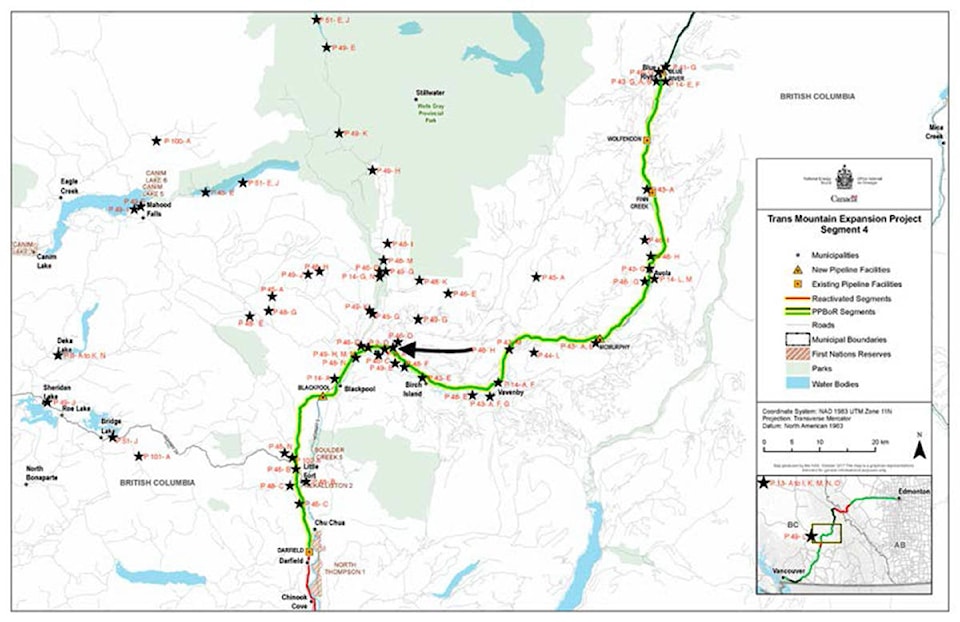The Metis peoples have a long history in the North Thompson Valley, and along the Trans Mountain corridor. There is a high population from McBride all the way to Kamloops. Reports of “half-breed” populations exist as early as 1793, with Alexander Mackenzie’s expedition into the Rockies.
In 1800, David Thompson noted 20 Metis families in the Kootenays region and ethnologist James Teit documented a band of Iroquois settled at Tete Jaune Cache in 1816. This band spoke both Cree and French and traded their flower beadwork with the Shuswap, who knew them as “Le Michif,” a term also used by Metis in Manitoba.
In B.C., Metis are both connected to historic Metis families, as well as the mixed Aboriginal communities that developed over the colonial era.
Research shows the Metis people have long had relationships with First Nations along the Trans Mountain corridor, as well as with the land, water and resources.
Despite this, self-determining Metis were cast aside in history due to their “mixed blood” status. As colonial settlers arrived in B.C., the seemingly empty-looking land was occupied as their own. Indeed, the Metis people suffered as they were seen as neither pure Anglo-Canadian nor First Nations by newcomers.
Therefore, it’s tough to determine which Metis communities occupied what spaces, though it’s clear they occupied and used the land in many different ways. While some communities are easily identifiable, others are not.
Despite this, it is believed many self-determining Metis peoples shaped the economic, social, cultural and political life of these areas. The “mixed-ancestry kinship communities” were able to blur the lines politically with the First Nations groups and economically with groups such as the Hudson Bay Company.
Their culture, knowledge of the land and waters, their ability to interpret and to speak and their relations with the First Nations peoples allowed them to broaden their influence throughout the regions they lived in.
Records show economic activity throughout the Trans Mountain corridor in both the 19th and 20th centuries was strongly influenced by the Metis people and their communities. Metis held positions as militia, labourers, boatmen, hunters, interpreters and guides, among others, due to the fluidity and complexity of the family.
These “half-breed” families also went on to establish ranches, mines, farms and mills.
Mixed race relations had long been frowned upon, and it was no different for the Metis. Despite discrimination and attempts to restrict their way of life, over 1,500 mixed-race households were recorded throughout B.C. by the 1890s.
Much of Metis history may have been erased or lost in B.C., but it didn’t stop them from continuing their way of life and practicing their culture, despite being evicted from their homes and forced into a new way of life.
Many kinship clusters lead a double life, adopting Anglo-Canadian norms in order to fit in on the outside, while continuing to practice their way of life at home.
Historically, the Metis have been put into a certain descriptive identifier, though research shows that can’t continue as the fluidity of the Metis identity shows there are many lived experiences of these peoples, requiring a broader definition.
During the early colonial years in B.C., the Metis people held both political and economic positions, including HBC Chief Factor and member of the Legislative Assembly Josette Legace and Isabella Ross, who was the first female to own land in the province.
In the 2016 federal census, of the Indigenous population in B.C., about one-third identified as Metis. In 2015, the Metis people made up over four per cent of the population in the North Thompson Valley.
Clearwater is home to the North Thompson Aboriginal Cultural Centre, which has partnered with many local groups and organizations for over 13 years. It’s also home to the only Metis-focused museum in B.C. the “Michif Metis Historical and Cultural Preservation Society.”
The BC Metis Federation is a community partner, supporting the community in financial and COVID support, as well as local events, including Louis Riel Day, National Indigenous Peoples Day, the Moose Hide Campaign, Red Dress Project, MMIWG, among many others.
The information in this piece was gathered from multiple documents, including www.bcmetis.com and the BC Metis Federation Terrestrial Study, as well as local elder, Cindy Wilgosh.
